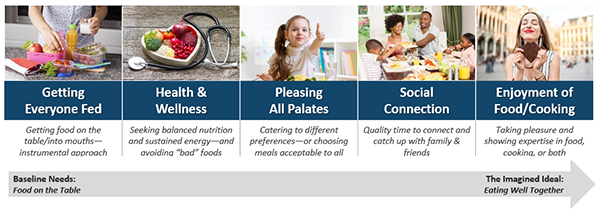For Whom Does the Dinner Bell Toll? Pining for the Way We Used to Eat — Even if It Was Only Imagined
 When many of us grew up, we sat down to dinner with Mom in charge. Everyone ate the same meal, at the same time. Today, that’s an outdated picture. The consumer lens has changed, and our modern, experiential consumer culture has given way to a dynamic contemporary culture of food and beverage.
When many of us grew up, we sat down to dinner with Mom in charge. Everyone ate the same meal, at the same time. Today, that’s an outdated picture. The consumer lens has changed, and our modern, experiential consumer culture has given way to a dynamic contemporary culture of food and beverage.
Health and wellness and cultural trends have progressively changed the American consumer’s eating and drinking patterns. These long-term shifts in broader cultural values and notions of a healthy diet have undermined “traditional” ways of eating, including what we eat, when we eat it, whom we eat it with and who makes it.
Mealtimes are not what we once thought them to be. Take morning eating as an example. Snacking, before or after breakfast, is as common as breakfast itself. There is a general cultural movement towards foods perceived as fresher with an increased interest in controlling sugar, particularly for kids, driving many consumers away from traditional cereal brands. Morning eating is more purposeful to manage sustained energy across the morning (protein plays a big role here as satiety and nutrient density). There is increased availability of “roadside pantries” for our on-the-go needs, as food service operators vie for breakfast occasions—from Starbucks to Panera, Subway, McDonald’s and more.
Meanwhile, demographic changes related to work, gender and parenting have reshaped how households approach food and eating when time and energy are scarce but food is abundant. As documented in our Transformation of the American Meal 2017 report, the consequence has been an overall erosion of mealtime rituals — especially breakfast and lunch — and of cooking in general.
And yet, a distant dinner bell is ringing: socially and culturally, there’s a yearning for an “ideal meal” of an imagined meal that persists — propped up by iconic memories and a palpable understanding that sitting down to eat together has significant benefits. In this imagined past, Mom lovingly planned and cooked balanced meals from scratch every day and served them family-style, and everyone enjoyed eating them together.
Few want to return to this vision of household roles, but consumers do want the imagined meal that results — a happy unification of good food that’s nutritious and delicious, good cooking that is skillful and from scratch, good company that is enjoyable and appreciative, and a meal made and eaten with a sense of joy and love.
The gap between the ideal meal and most consumers’ reality is largely the result of an overall minimization of importance for meals and cooking. Key to understanding how meals happen today is understanding that rather than schedule our days around mealtimes, we schedule our meals around everything else that might be going on in our days. Within dayparts, breakfast is highly functional, driven by habit and the need for morning energy. Lunch often falls victim to snacking. Whether lunching or snacking, many consumers are simply eating to get through the afternoon until dinner.
A holdout on eroding customs, dinner has become the mealtime ritual’s last stand and is often looked to as an antidote to the routines of breakfast and the haphazard grazing characterizing the rest of the day. Dinner is the least likely meal to be skipped and the most likely to be eaten with others. Unlike breakfast and lunch, dinner is typically planned in advance and is focused on as a means of enjoyment for both food and company. How dinner comes together is complex and can occur on a spectrum, depending on priorities (Figure 1). Consumers today shape dinner plans around key priorities, which are related to but not synonymous with aspects of the ideal meal.
Figure 1: Today’s dinnertime priorities can be viewed as a spectrum that eventually sums to the imagined ideal
Source: Transformation of the American Meal 2017 report, The Hartman Group
The common themes represented in Figure 1 are not mutually exclusive but are broadly additive in that they encompass more of the ideal moving from left to right. Households’ emphasis on different priorities for dinner shift depending on the day of the week as well as other factors.
In terms of opportunities to help consumers with how they actually achieve dinner amidst their imagined ideals, food retailers, manufacturers and restaurant operators have numerous options to assist: for example, compared to breakfast and lunch, dinner shows the widest variety of food types consumed of all the meals. And yet, while most consumer meal planning focuses on dinner (because it’s the meal with the most potential inputs), that doesn’t mean they enjoy it. Breakfast and lunch are more routine than dinner, and planning for them tends to focus on simply having easy options readily at hand.
Planning for dinner, typically the most important meal of the day, takes more thought, and for many this makes it less enjoyable. In addition to coordinating schedules, duties and ingredients, dinner also has the largest set of options when it comes to what to eat. Dinner involves more pressure than other meals as cooks must consider more logistics, food and sourcing options, creativity, time and energy. For many cooks, having a plan in place ahead of time is key to cooking at home vs. outsourcing. Dinner planning includes so many inputs that for many, making last-minute dinner plans is simply too mentally taxing after a long day — it’s easier to simply order in or go out to eat.
Though many consumers say the decision to outsource is about time, it is often more about avoiding the mental and physical labor of planning and cooking a meal, since in the time it takes to go out or have a pizza delivered, one could conceivably whip up something quick.
Ringing the Dinner Bell for Opportunities
Opportunity spaces exist for helping make the dinner-planning process more enjoyable for consumers. Wegmans, for example, sends detailed email messages with clearly communicated ingredients, recipes and pictures of both heat-and-eat options as well as components available in their stores that comprise a dinner.
The value attached to dinner suggests consumer investment and capacity for trying new solutions that deliver on specific dinner priorities, such as social connection, pleasing all palates or health and wellness. Solutions with staying power will be those that also bring dinner more in line with the ideal. Solving for consumers’ common desire for meals that are both healthy and delicious is likely the best starting point, especially if they can successfully bridge the gap between consumers’ healthy ideals and indulgent desires. Meal kits often do this for those who have tried them, but resistance to the subscription model means opportunity for retailers to successfully piggyback on this idea.
Dinner is truly an oasis of opportunity in an otherwise routinized and snackified world of eating: of interest to all food producers ranging from CPG to restaurants, half of consumers report deviating at least once a week from dinner plans, suggesting that changing plans are themselves a routine part of dinnertime (and represent an open invitation to suggestions).
Learn more: Transformation of the American Meal 2017 report

